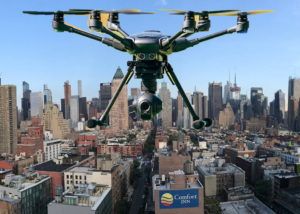Aug 10, 2018
Driverless cars will be in use everywhere within 6 years
Posted by Michael Lance in categories: robotics/AI, transportation
Traffic jams could be a thing of the past. Learn more about a driverless future: https://wef.ch/2Op4rCc

Traffic jams could be a thing of the past. Learn more about a driverless future: https://wef.ch/2Op4rCc
 Until this past year, consumer drones carried tiny ultralight cameras, but they just didn’t have the energy or the reserve to carry much else. They certainly could not deliver much of a product or payload. They flew for 15 minutes, lacked the capacity to carry excess weight, and had short range.
Until this past year, consumer drones carried tiny ultralight cameras, but they just didn’t have the energy or the reserve to carry much else. They certainly could not deliver much of a product or payload. They flew for 15 minutes, lacked the capacity to carry excess weight, and had short range.
But market demand sparks innovation. Amazon and Domino’s Pizza are experimenting with drone delivery. The improvements needed to serve these needs are quickly bubbling down to unlicensed weekend pilots. Hexacopters with 4K cameras, gimbals and retracting landing gear are available for under $400. Tiny foldable drones with 720p cameras are available for $35. Some models don’t even need a pilot on a joystick. You can preprogram the flight path to reach any target using GPS, or you can guide them by making gestures with your hand. The drone actually looks back over its shoulder and responds to your hand-waving commands.

Lance Ulanoff is a cartoonist and robotics fantech expert. But he shares a lot in common with Wild Ducks. He is an eclectic journalist and social media commentator.
Continue reading “Drone Assassination Attempt Foreshadows Future Events” »
They used to be the billion dollar start-ups. Now we call them unicorns, a term coined five years ago by Aileen Lee of Silicon Valley-based Cowboy Ventures. In mythology, unicorns are rare, beautiful creatures. It was the perfect name – until recently.
Now unicorn is taking on new meaning: start-ups that perpetuate the myth that they are worth a billion US dollars.
These days, it does not take much money to claim a US$1 billion valuation – under US$200 million in some cases. Nor do you have to be a leading edge or disruptive tech company. Many unicorns, especially those in China, are simply smartphone apps applied to businesses that have been around for decades.
Continue reading “The only thing mythical about unicorns these days is their valuation” »
A University of Manchester PhD student has developed a prototype flexible heat shield for spacecraft that could reduce the cost of space travel and even aid future space missions to Mars.
Surprise! But there’s a good chance you still may not be able to buy it. Here’s everything you need to know.

If the weather remains favorable and everything goes according to plan on August 11th, NASA is sending a spacecraft to the sun. The Parker Solar Probe will go closer to the massive ball of gas and plasma keeping our solar system together than any other spacecraft has gone before. It will brave extreme temperatures reaching up to 2,500 degrees Fahrenheit to collect data and images of the sun’s atmosphere called “corona.” The spacecraft will also reach speeds up to 430,000 mph, making it the fastest-ever human-made object. That’s nowhere near fast enough to reach Alpha Centauri within our lifetime — it has to travel around 7,000 years to reach the star closest to our sun — but fast enough to get from Philadelphia to DC in a second.
NASA plans to use the data it beams back to figure out how we can better prepare for solar winds, which are streams of charged particles emitted by the corona. Particularly strong winds could change satellites’ orbits, interfere with their instruments and even affect power grids here on Earth. If we want to head deeper into space in the future, we must first study how solar winds can affect our vehicles. Besides, we need to take a closer look at the star nearest to us if we want to learn more about the other stars in the universe. Finally, studying the sun could shed light on the origin of life on Earth, since it’s our source of light and heat.
Continue reading “The fastest human-made object launches for the Sun this Saturday” »
All humans begin life as a single cell that divides repeatedly to form two, then four, then eight cells, all the way up to the ~26 billion cells that make up a newborn. Tracing how and when those 26 billion cells arise from one zygote is the grand challenge of developmental biology, a field that has so far only been able to capture and analyze snapshots of the development process.
Now, a new method developed by scientists at the Wyss Institute and Harvard Medical School (HMS) finally brings that daunting task into the realm of possibility using evolving genetic barcodes that actively record the process of cell division in developing mice, enabling the lineage of every cell in a mouse’s body to be traced back to its single-celled origin.
The research is published today in Science as a First Release article.
Continue reading “Recording every cell’s history in real-time with evolving genetic barcodes” »
A controversial new paper argues that universes with dark energy profiles like ours do not exist in the “landscape” of universes allowed by string theory.
New Horizons may have seen a hydrogen wall just past the edge of the solar system, where the solar wind meets the stuff of interstellar space.
What if an ultra-advanced flying robot designed for extreme military missions could join the fight to combat wildfire alongside human fire crews?
The biggest wildfire in Californian history is raging, with fire officials stating earlier this week that an area almost the size of Los Angeles has been compromised.
It is actually expected to burn through the rest of August, and experts predict the escalation in frequency and scale of wildfires will only continue going forward.
Continue reading “A military helicopter drone that can fight wildfires” »